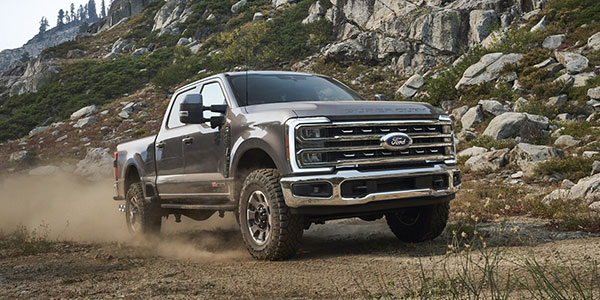7.3 Power Stroke | 1994 - 2003 Ford F-Series/Super Duty
| Model Year(s) | Horsepower | Torque |
| 1994 - 1995 | 210 hp @ 3,000 rpm | 425 lb-ft @ 2,000 rpm |
| 1996 | 215 hp @ 3,000 rpm | 450 lb-ft @ 2,000 rpm |
| 1997 | 225 hp @ 3,000 rpm | 450 lb-ft @ 2,000 rpm |
| 1999 - 2000 | 235 hp @ 2,700 rpm | 500 lb-ft @ 1,600 rpm |
| 2001 - 2003 | 250 hp @ 2,600 rpm (automatic) 275 hp @ 2,800 rpm (manual) |
505 lb-ft @ 1,600rpm (automatic) 525 lb-ft @ 1,600 rpm (manual) |
1994 - 1997 Ford F-Series "OBS"
The 1994 to 1997 Ford F-Series is a prized truck platform renowned for its styling and powertrain options. While the "OBS" (old body style) body was first introduced for the 1992 model year, it wasn't until midway through the 1994 model year that the 7.3L Power Stroke turbodiesel was offered. Note that the Ford F-150 shared the same body and configuration as the 3/4 and 1 ton truck models through 1996; the largest engine available in the F-150 was Ford's 351 Windsor V-8 (5.8L).
Models available with the 7.3L Power Stroke included the F-250, F-350, and F-Super Duty, a chassis cab configuration equivalent to the more modern F-450. Mated to the engine was either a Ford E4OD four speed automatic transmission or ZF S5-47 five speed manual. Four wheel drive F-250 models received the less popular Dana 50 twin traction beam front differential with independent suspension, while F-350 and F-Super trucks featured the venerable Dana 60 solid front axle. Transfer case options were limited to BorgWarner chain driven units, but they have proved widely reliable.
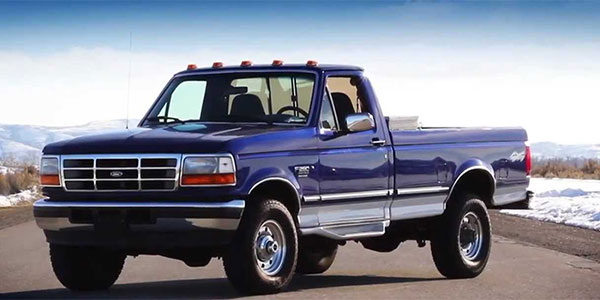
1999 - 2003 Ford Super Duty
The Ford Super Duty may likely be one of the most popular truck platforms in both commercial and noncommercial segments. It is highly praised for its confident trailer handling capabilities, driver visibility, and overall ruggedness. Note that there was no 1998 model year F-Series; the transition to the Super Duty platform skipped 1998.
Ford's newly launched 1997 Ford F-150 also separated itself from the larger 3/4 and 1 ton trucks; the F-150 and Super Duty models have never shared a chassis or body panels since 1997. The introduction of the Super Duty also saw two new models, the F-450 and F-550 chassis cab trucks.
During these years, the 7.3L Power Stroke was mated to a Ford 4R100 four speed automatic transmission or ZF S6-650 six speed manual transmission. All four wheel drive vehicles received the Dana 60 solid front axle and a New Venture NV-273 chain driven transfer case, available in manual or electric shift variants.
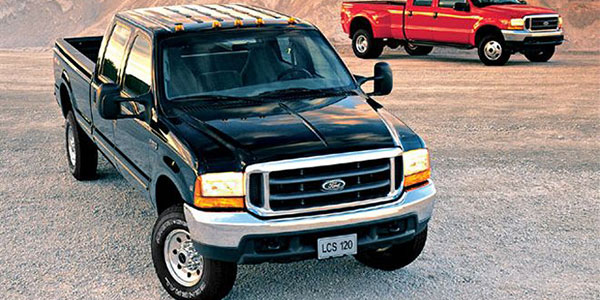
6.0 Power Stroke | 2003 - 2007 Ford Super Duty
| Model Year(s) | Horsepower | Torque |
| 2003 - 2004 | 325 hp @ 3,300 rpm | 560 lb-ft @ 2,000 rpm |
| 2005 - 2007 | 325 hp @ 3,300 rpm | 570 lb-ft @ 2,000 rpm |
The 2004 model year Ford Super Duty did not differ much from the 1999 to 2003 platform. For 2005, Ford transitioned to a coil-over front suspension while retaining the Dana 60 solid from differential. The ride quality is slightly less harsh in 2005 to 2007 vehicles as a result of the coil over suspension, but the trucks remained equally stout.
With the 6.0L Power Stroke came a new transmission, the 5R110W TorqShift five speed automatic. This transmission is particularly praised for its reliability, longevity, and sophisticated shift schedule that compliments the Power Stroke's torque curve well. Although the 6.0L Power Stroke suffered major reliability issues, these trucks remain reasonably sought after now that most of the engine's flaws are addressable with either aftermarket or OE solutions. A heavier version of the ZF six speed manual transmission, the S6-750, was also offered behind the 6.0L Power Stroke.
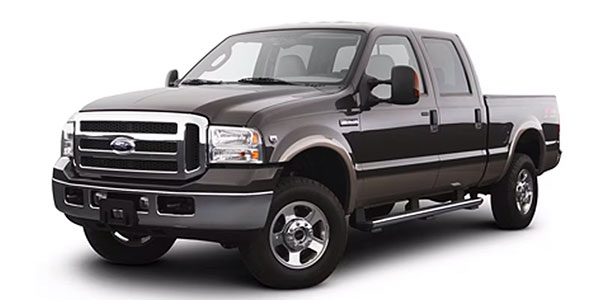
6.4 Power Stroke | 2008 - 2010 Ford Super Duty
| Model Year(s) | Horsepower | Torque |
| 2008 - 2010 | 350 hp @ 3,000 rpm | 650 lb-ft @ 2,000 rpm |
The Ford Super Duty received a fairly significant redesign for the 2008 model year, including the introduction of the 6.4L Power Stroke. The new diesel boasted a high pressure common rail injection system and twin sequential turbocharger system. With significantly more torque and better throttle response than the previous 6.0L, the 6.4L Power Stroke was an easy sell. The engine's flat torque curve and strong mid-range make it well suited for towing.
Unfortunately, the 6.4L Power Stroke may have fell short in the reliability category and there not particularly known for their longevity. Furthermore, there quite difficult for the average shade tree mechanic to work on due to fairly extensive spacial restraints. Much of the engine platform's problems can be attributed to its exhaust aftertreatment system; being the first of its kind, the system was far from reliable and it would take Ford some time to make a more efficient, refined system. Additionally, poor fuel economy resulting from periodic regeneration cycles was not necessary what customers had come to expect.
6.4L Power Stroke equipped Super Duty's were equipped with either the 5R110W TorqShift five speed automatic transmission or the ZF S6-750 six speed manual transmission, both of which were carried over from the previous generation platform.
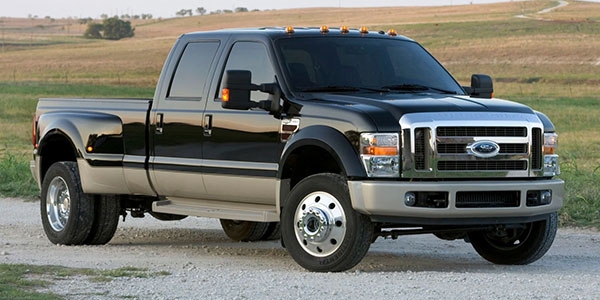
6.7 Power Stroke | 2011 - 2023 Ford Super Duty
| Model Year(s) | Horsepower | Torque |
| 2011 | 390 @ 2,800 (original) 400 @ 2,800 (updated) |
735 @ 1,600 (original) 800 @ 1,600 (updated) |
| 2012 - 2014 | 400 @ 2,800 | 800 @ 1,600 |
| 2015 - 2016 | 440 @ 2,800 | 860 @ 1,600 |
| 2017 | 440 @ 2,800 | 925 @ 1,600 |
| 2018 - 2019 | 450 hp @ 2,800 rpm | 935 lb-ft @ 1,800 rpm |
| 2020 - 2022 | 475 hp @ 2,800 rpm | 1,050 lb-ft @ 1,800 rpm |
| 2023 - 2024 | 475 hp @ 2,800 rpm (standard output) 500 hp @ 2,600 rpm (high output) |
1,050 lb-ft @ 1,800 rpm (standard output) 1,200 lb-ft @ 1,600 rpm (high output) |
2011 - 2016 Ford Super Duty
The entirely redesigned 2011 Ford Super Duty experienced profound popularity, particularly for the new 390 horsepower, 735 lb-ft 6.7L Power Stroke diesel. It was at this juncture that Ford Motor Company had cut ties with International-Navistar and had designed, developed, and manufactured their own turbodiesel entirely in-house. Several months after its launch, Ford offered a free calibration upgrade to 6.7L Power Stroke owners in response to GM's release of power and torque figures for their new Duramax diesel. Ford's new calibration increased power to 400 horsepower and torque to 800 lb-ft, ousting the new Duramax's ratings.
Although the 6.7L Power Stroke received several power and torque increases through the 2016 model year, the Super Duty platform remained relatively unchanged. All 2011 to 2016 Ford Super Duty pickup and chassis cab trucks used the Ford 6R140 TorqShift six speed automatic transmission, a revised version of the 5R110W that featured a shorter 1st gear ratio and two overdrive ratios, presumably to lower cruising RPMs and improve fuel economy.
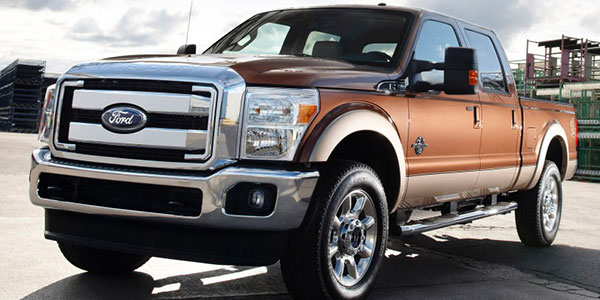
2017 - 2023 Ford Super Duty (Aluminum Bodied)
2017 was a big year for the Ford Super Duty, which featured an entirely redesigned body and chassis. The new all-aluminum body saved considerable weight, which Ford reinvested in the chassis. The 6R140 automatic transmission was employed exclusively through the 2019 model year. For 2020, Ford introduced and made standard the 10R140 TorqShift 10 speed automatic transmission. All 2020 and newer Ford Super Dutys also produce over 1,000 lb-ft of torque, with a high output engine option being made available for the 2023 model year. The high output 6.7L Power Stroke produces 500 horsepower and 1,200 lb-ft of torque. While it might not seem significant, its acceleration characteristics are notably superior to the standard output engine.
